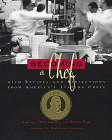
Seabee
Food Service in WW II
The Story of the Can
Do! Cooks and Bakers
By Steve Karoly
[Hot Meals to All] [Equipment Shortages] [Food
Shortages]
[Can Do! Ingenuity] [Fighter Cooks]
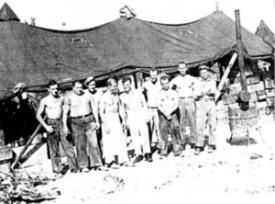 "Seabee
chow," writes William Bradford Huie in Can Do!
The Story of the Seabees, "is famous on every
front." As a Seabee officer and war correspondent,
Seabee cooks impressed Huie. Speaking of Chief Commissary
Steward Allen from the 43rd Naval Construction Battalion,
Huie states Chief Allen "performed some magic with
hamburger and onions" when he met him for a late
night snack.
"Seabee
chow," writes William Bradford Huie in Can Do!
The Story of the Seabees, "is famous on every
front." As a Seabee officer and war correspondent,
Seabee cooks impressed Huie. Speaking of Chief Commissary
Steward Allen from the 43rd Naval Construction Battalion,
Huie states Chief Allen "performed some magic with
hamburger and onions" when he met him for a late
night snack.
While the Seabees were adding up construction feat upon feat, their cooks and bakers performed similarly. Huie states, "The Seabee commissary stewards were as ingenious as the rest [of the Seabees]." Ingenuity is a Seabee trademark. Seabee cooks dished out hot, wholesome meals to their men even under the most formidable conditions.
Seabee cooks serve hot meals fast and to all
Huie said it was "Navy policy" to feed all from adjacent units, Navy or Army, as long as the food lasted. Many battalions took pride in delivering hot food soon after landing on the beaches. Often, they supplied hot meals to Marines and soldiers in combat. Chief Commissary Steward Henri Dupre of the 133rd Seabees operated twenty-four hour coffee stations on Yellow and Blue beaches during the fight for Iwo Jima.
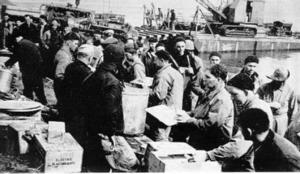
In August 1943, the 38th Seabees landed unopposed at Kiska in the Aleutian Islands. Their first hot meal was served that afternoon right on the beach. Chief Commissary Steward J. H. Mitchell had chow delivered to him from the ship's galley. The next day, Chief Mitchell catered Yankee pot roast, browned potatoes, brown gravy, green snap beans, Bartlett pears, bread, butter and coffee from his own field mess. In addition to the 38th Seabees, he served troops from six nearby Army units, the Navy Amphibious Force, and the Canadian forces.
Seabee cooks take equipment shortages with a Can Do! Attitude
Many battalions in the early days of the Pacific war had to content with shortages of galley equipment. The 6th Seabees' galley equipment "disappeared" while unloading from ships anchored in Iron Bottom Sound off Guadalcanal in September, 1942. Fortunately, they were able to salvage some of the equipment. However, until repairs were made, the Sixth messed with a nearby Marine tank battalion. One Navy photograph shows a Seabee baker from the Sixth baking in a oven made from a converted Japanese safe.
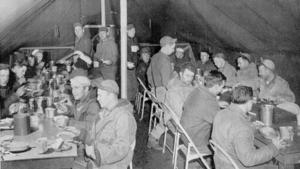
Seabee cooks make food shortages look like a feast
If it were not for the efforts of one Seabee chef, Chief Commissary Steward Ben C. Rudder, the Sixth may have had a much more arduous first three months ashore in August of 1942. Chief Rudder was faced with a problem that troubled many galley chiefs during the early days of the war: How to feed acceptable, nutritious meals to his troops using short rations that were less than pleasing. Here's how he did it:
"Two meals a day consisting of captured [Japanese] rice and oats or spaghetti, along with an occasional side dish of canned franks or 'corned willie,' made up the menu for nearly a month. There was boiled rice, rice pudding, chili and rice, and rice with raisins."
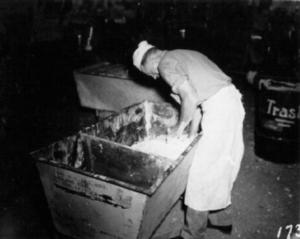
Can you visualize Chief Rudder as a culinary master, taking scarce, redundant provisions and sustaining the Sixth with wonderful culinary delights for his men? True to the Seabee "Can Do" spirit, the battalion soon built refrigeration units and were able to serve turkey dinners for Thanksgiving and Christmas.
Seabee cooks proudly display Can Do! Ingenuity
Seabee galley chiefs had quite a challenge even when equipment and food were plentiful. Lcdr. Joseph L. Howard, a Seabee supply officer, describes what two battalions did to overcome problems: The first battalion, assigned to the Manus Islands, solved the problem of provisioning four-100 man detachments scattered throughout neighboring islands by refurbishing a captured Japanese barge with storerooms and a propulsion unit. When the supply officer finished, he had a "supply ship" that traveled to each detachment several times per week providing them with food stores, clothing and a ship's store.
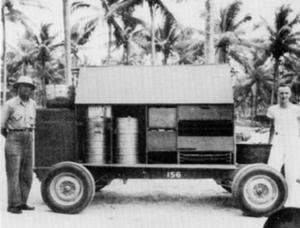 A "chuck wagon," constructed using
a cargo trailer, solved a serious problem for another
battalion. The chuck wagon traveled to distant
construction projects at meal time. Seabees crews were
fed at the construction site, saving valuable work hours
spent transporting then to and from the main galley. The
chuck wagon boosted morale. The men were able to relax at
meal time. They did not have to take the long, bumpy trip
back and forth between the main camp and project site at
meal time.
A "chuck wagon," constructed using
a cargo trailer, solved a serious problem for another
battalion. The chuck wagon traveled to distant
construction projects at meal time. Seabees crews were
fed at the construction site, saving valuable work hours
spent transporting then to and from the main galley. The
chuck wagon boosted morale. The men were able to relax at
meal time. They did not have to take the long, bumpy trip
back and forth between the main camp and project site at
meal time.
A visit to Joe's Hamburger Stand, nestled against the air field in the Russell Islands, convinced even the most critical skeptics of the inspiring abilities of Seabee cooks. Chief Commissary Steward Joe Hayden of the 33rd Seabees took two battered pontoons and converted them into an oven and griddle. The oven had a door cut into the side with shelves installed. A gasoline fire unit provided heat. The griddle, hamburgers and hot cakes sizzling on the surface, had a roaring fire inside.
To further complicate matters, Chief Hayden, civilian caterer turned Seabee chef, must not have had a good supply of hamburger meat and side orders. To resolve the problem, he persuaded his supply officer to purchase cattle from a local herd, set up a slaughtered house, and ground 400 pounds of beef each day by hand. Bartering with local residents, Chief Hayden obtained fresh potatoes, fruit for juice and an occasional crate of eggs for his establishment. The 33rd's Mess Hall, build to serve Seabees, was soon invaded by the pilots from the airfield.
Seabee Cooks Are Builders, Fighters
Do not underestimate the adaptability of Seabee cooks. Lt. Harold F. Liberty's now famous "Forgotten Fifty-five" had a multi-talented cook. "The cook could drop his skillet and run a winch or string a pipeline", reports the OIC of the Motor Torpedo Boat Advanced Base Construction Detachment from the 113th Seabees. This builder-fighter-cook, part of the "best damn team in the Pacific," also had to be a gunner when called.
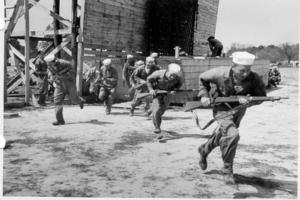
Headquarters Company (also known as the "telephone girls") of the 133rd Seabees landed on Iwo Jima at four P. M. on February 19, 1945. The cooks were pressed into service as ammunition passers for a machine-gun unit. The next day Ship's Cook First Norman V. Dupuis was killed by enemy fire. Two, Ship's Cook Second Henry J. Gross and Ship's Cook Third John H. Mills, were wounded in the same action. A third, Ship's Cook First Thomas E. O'Malley, also received the Purple Heart for wounds in the battle for Iwo Jima.
That's the story of Seabee cooks. They have developed quite a reputation for today's Seabee cooks to follow.
Bibliography
Blundon, J. Paul, ed. Saga of the
Sixth: A History of the Sixth U. S. Naval Construction
Battalion, 1942-1945. n. p., c. 1945. 97p. Mawdsley:
451.
The cruise book for the 6th Seabees in World War II.
Howard, Joseph L. "Seabee Supply
was Big Business." United States Naval Institute
Proceedings, No. 527 (January 1947), 40-5. Smith:
9890.
A detailed description of the supply department of a
construction battalion.
Huie, William Bradford. Can Do!: The
Story of the Seabees. New York: E. P. Dutton, 1944.
250p. Smith: 9891.
Huie, editor of the American Mercury and author of
two books (Mud on the Stars and The Fight for
Air Power) before joining the Seabees, presents the
Seabee story, often in their own words. He introduced the
concept of the five roads to victory so often seen in
World War II Seabee writings. Appendices include lists of
awards and casualties and an introduction to Seabee
poetry. The introduction is written by (then) Vice
Admiral Ben Moreell.
________. From Omaha to Okinawa: The
Story of the Seabees. New York: E. P. Dutton, 1945.
257p. Enser: p. 314. Smith: 9892. Ziegler: 2613.
Huie continues his earlier work, sharing Seabee
adventures during the last year of the war. Appendices
include a listing of every Seabee battalion and were they
served in World War II.
| Bulletin Board | Keyword Search |
| Bookstore | Links |
| About Us | Recent Additions |

